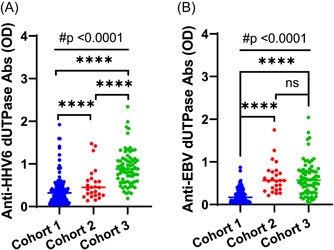While latent and lytic states of human herpesviruses are well established, investigators led by Maria Ariza at Ohio State University argue that abortive lytic states also may be common. Previous research by these investigators found that levels of antibodies to dUTPase early proteins is a biomarker for abortive lytic states. The investigators argue that antibody levels to these proteins also need to be characterized in healthy and disease populations, and report levels in older, “healthy” populations.
Using an ELISA assay, the investigators measured dUTPase antibodies to HHV-6A/B, EBV, HSV-1 and VZV in three cohorts of people (N=255) characterized as “healthy”, whose average ages were 47 (Cohort 1), 50 (Cohort 2) and 66 (Cohort 3).

Figure 1: Levels of anti-HHV 6 and anti-EBV dUTPase antibodies in three “healthy” cohorts of increasing average age.
As shown in Figure 1, below, levels of dUTPase antibodies to both HHV-6 and EBV were significantly higher in the older age groups.
It remains to be shown in studies of “healthy” populations of different age groups that dUTPase antibody levels rise with increasing age. It also will be important to study whether there is a correlation between dUTPase antibody levels and various disease states. It is claimed that dUTPase acts to modulate innate immunity, so links to disease states are plausible. Indeed, increased levels of dUTPase antibodies previously have been found to be higher in people with myalgic encephalomyelitis/chronic fatigue syndrome (ME/CFS) (Williams 2019).
Read the full article: Alharshawi 2022

